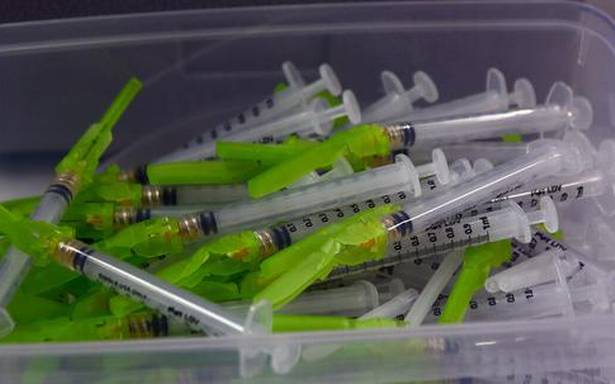But classes of syringes not used for COVID-19 vaccines can be sent abroad.
The Government has imposed a three-month restriction on exports of three categories of syringes to ensure that there is enough to “improve domestic uptake and availability”. However complying with demands from local industry, it has allowed exports of classes of syringes not used for COVID-19 vaccines.
Most syringes used in COVID-19 vaccination have a capacity of 0.3 ml though bigger ones are also used.
Following a meeting on Saturday on the progress of COVID-19 vaccination, Union Health Minister Mansukh Mandaviya told senior health officials in states, that the “immediate milestone” in India’s COVID-19 vaccination journey was completing administration of 100 crore doses. India has so far administered 94 crore vaccine doses.
The three categories of syringes that will be subject to this “quantitative restriction” on exports are 0.5 ml/ 1ml AD (auto-disable) syringes, 0.5 ml/1 ml/2 ml/3 ml disposable syringes, 1ml/2 ml/3 ml RUP (re-use prevention) syringes.
Earlier this week, the Directorate General of Foreign Trade (DGFT), a Commerce Ministry body, issued a notification that the export policy for syringes, with or without needles, has been amended from “free” to “restricted”. The notification drew protests from the All India Syringes and Needles Manufacturing Association (AISNMA) which also said that it “tarnished” India’s reputation as credible global supplier and manufacturing hub for syringes.
However, following the Union Health Ministry’s statement on Saturday, the All India Syringes and Needles Manufacturing Association (AISNMA) “welcomed” the easing on syringes not used for COVID-19 vaccination.
“So the syringes that are not used for COVID vaccination like Insulin Syringes, 0.3 ML, 5 ML and larger sizes of 10 ML, 20 ML & 50 ML etc will be allowed to be exported. This is definitely going to be a relief for India’s international buyers and will majorly help to maintain India’s reputation as credible global supplier and our relationship built over the years with them,” Rajiv Nath, President, AISNMA, said in a statement.
Mr. Nath, the Managing Director of Hindustan Syringes & Medical Devices (HMD) Ltd. said his company on Friday offered the Centre 10 crore syringes in addition to their outstanding orders of 23.2 crore syringes for delivery by January end. The Centre, in response, had reportedly ordered 7.5 crore syringes.
“We again request the Union government to place orders for AD syringes with the manufacturers in India well in advance so that the latter could ramp up supplies. Clarity should be given of India’s quarterly needs by MoH&FW for calendar year 2022 as we can’t plan on a 2-4 months window horizon basis. To ramp up capacity, we need an order confirmation at least nine months to a year in advance,” said Mr. Nath.
India is currently producing more vaccines than its production of Auto Disable (AD) syringes — the preferred choice for COVID-19 vaccination. However, vaccination can be given also by Standard Disposable Syringes with a 0.5 ML / 1 ML / 2 ML or 3 ML Syringes. Between the 20 manufacturers of AISNMA, India’s manufacturing capacity is over 500 million syringes per month and usually 30-50% is spare capacity.
At Saturday’s meeting, Uttar Pradesh had pointed out the “comparatively limited supply of Covaxin” and its shorter span between the doses as a reason why vaccination wasn’t proceeding as fast as it could, said a statement from the Press Information Bureau.
Previous estimates in April by Bharat Biotech had claimed that production would scale to over six crore doses a month by September but actual supply is much lower. Chairman Bharat Biotech Krishna Ella had said in September that output would be scaled to 5.5 crore doses by October.
For India to meet its goal to fully inoculate all adults by the year end, it needs to vaccinate over a crore every day but has consistently averaged a little less than 80 lakh a day since the 2.5 crore doses on September 17.
Mr Mandaviya said more than 8 crore doses were available with States. Many States were nearing “saturation of coverage” in urban areas, he added.
Source: Read Full Article

